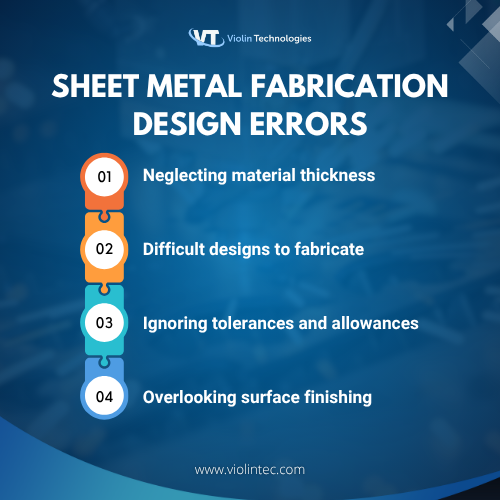Sheet metal fabrication is a cornerstone of countless industries, from aerospace to electronics, automotive, and construction. Yet, even experienced engineers and designers can stumble upon common design errors that complicate manufacturing, increase costs, or compromise product quality. Understanding these pitfalls early in the design phase can save time, reduce rework, and ensure your final parts meet both functional and budgetary goals.
This blog walks through the top four design errors found in sheet metal fabrication and offers practical tips to prevent them.
What we cover in this blog?
Common Design Errors and How to Prevent Them
1. Neglecting Material Thickness and Bend Allowance
One of the foundational aspects of sheet metal design is accurately accounting for material thickness and its deformation during bending. Overlooking these details leads to dimensional inaccuracies and poor assembly fit.
Why it Matters:
Sheet metal stretches and compresses at the bend areas, altering the part’s dimensions. If the bend allowance or bend radius is not properly calculated, the finished part can be too tight or loose.
Prevention Tips:
- Always use bend allowance formulas or trusted software tools to calculate flat patterns.
- Choose appropriate bend radii based on material thickness and type (e.g., aluminum vs. steel).
- Avoid excessively tight bends that could crack or weaken the metal.
2. Designing Features That are Difficult or Impossible to Fabricate
Complex, intricate features might look great in CAD models, but some designs push beyond fabrication capabilities.
Common Problem Areas:
- Extremely small holes or slots below the tool’s minimum punch size.
- Sharp internal corners are hard to form or stamp accurately.
- Features that require multiple bending axes without proper sequencing.
Prevention Tips:
- Consult closely with custom sheet metal fabricators to understand tooling limitations.
- Stick to standard hole sizes and avoid sharp inside corners; use relief cuts or radius corners instead.
- Simplify bend sequences and, where possible, maintain consistent bend directions.

3. Ignoring Tolerances and Allowances for Assembly
Parts rarely exist in isolation. When designing sheet metal parts, failing to account for tolerances and allowances for joints, welds, or fasteners can lead to headaches during assembly.
Consequences:
Parts may not fit together well, requiring time-consuming rework or leading to weak joints.
Prevention Tips:
- Work with assembly engineers early to define realistic tolerances.
- Include features like tabs, slots, or notches to aid alignment.
- Build in clearance where welding or fastening will occur to allow for distortion or material buildup.
4. Thermal Management
Designing a part without considering how it will be finished can result in costly surprises and performance issues later.
Key Considerations:
- Some materials react differently to finishing processes like painting, powder coating, or anodizing.
- Features such as deep recesses or sharp edges may trap coatings, resulting in uneven coverage.
- Post-fabrication handling and fixturing can affect final surface quality.
Prevention Tips:
- Specify the intended finishing process early and factor it into the design.
- Avoid features that complicate coating applications.
- Specify surface flatness and avoid sharp edges that could chip or peel coatings.
Remember, effective communication with your sheet metal manufacturing partner early in the project is key; they bring hands-on expertise that can help identify potential pitfalls before they become costly problems.
Final Thoughts
Avoiding these common sheet metal fabrication design errors requires careful planning, collaboration with fabricators, and the use of modern design tools. When you anticipate material behavior, manufacturing constraints, assembly needs, and finishing processes at the design stage, you streamline production, reduce costs, and increase product reliability.
By mastering these four design principles, you pave the way for successful sheet metal parts and assemblies that meet your exacting standards without friction.

